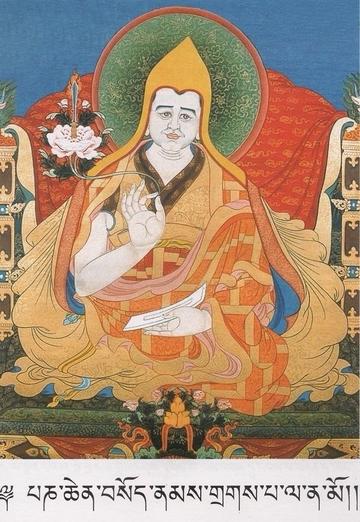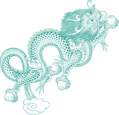The New Red Annals
Deb ther dmar po gsar ma
Introduction
The text was written by Sonam Drakpa (Bsod nams grags pa) (1478–1554) in around 1538. Sonam Drakpa was the abbot of the Gelukpa monasties of Drepung (ʼBras spungs), Sera (Se ra), and Ganden (dGa’ ldan), in succession. This was a period of warfare, political manoeuvring, and struggles for power in central Tibet, principally between the Rinpung (Rin spungs) and Tsang (gTsang) families
Schaeffer (2013: 352) describes the text as a ‘political and military history’. It was intended to supplement the Red Annals (Deb ther dmar po), written in the mid fourteenth-century by Tsalpa Kunga Dorjé (Tshal pa Kun dga’ rdo rje).
Download this resource as a PDF:

Sources
The Red Annals. Recension nova. 1968. New Delhi: Reproduced by Prof. Lokesh Chandra from an incomplete manuscript in the library of Rai Bahadur Densapa in Gangtok, Sikkim. BDRC: W940
Rgyal rabs 'phrul gyi lde mig gam deb ther dmar po gsar ma'am deb gsar ma. 1989. Lhasa: Bod ljongs mi dmangs dpe skrun khang. BDRC: W21657
Tucci, Giuseppe. 1971. Deb T’er Dmar Po Gsar Ma. Rome: Istituto Italiano per il Medio ed Estremo Oriente. [Contains the photographic reproduction of a manuscript version from Lhasa and an English translation].
References
Schaeffer, Kurtis. 2013. Battles over Central Tibet. In K.S. Schaeffer et al. (eds), Sources of Tibetan Tradition. New York: Columbia University Press.
Outline and Extracts
The outline and extracts below are drawn from the manuscript reproduced in Tucci (1971), using the folio numbers indicated there.
1 Introduction
2 The royal genealogies of India
3 The royal genealogies of Shambhala
4 The royal genealogies of Tibet
5 The royal genealogies of China and the Hor
6 The manner in which the Chinese and the Hor came to rule over Tibet
7 [Other polities and great estates]
Introduction
[fol 1a]
རྒྱལ་རབས་འཕྲུལ་གྱི་ལྡེ་མིག་ཞེས་བྱ་བའི་དེབ་ཐེར་གསར་མ། བཅོམ་ལྡན་འདས་དེ་བཞིན་གཤིགས་པ་དགྲ་བཅོམ་པ་ཡང་དག་པར་རྫོགས་པའི་སངས་རྒྱས་ཁྲིམས་གཉིས་ཀྱི་བདག་པོ་ལ་ཕྱག་འཚལ་ལོ།
A new chronicle named An Introduction to the Marvellous Royal Genealogies. Homage to the Bhagavan Tathāgata, the arhat who is the completely perfect Buddha, the master of the two laws.
The royal genealogies of Tibet
This chapter contains an account of the genealogies of the Tibetan emperors. In the time of Songtsen Gampo (Srong brtsan sgam po), it is said, Tonmi Sambhota (Thon mi sam bho ta) was sent to India to learn writing and grammar, after which he made the Tibetan alphabet. It recounts how ministers were sent to Nepal to ask for the princess, as wife for the king. Ministers were then sent to China to ask for the Chinese princess as wife for the king. The Chinese king was not pleased, however, and said:
[fol 19a]
ཁྱེད་བོད་ཀྱི་རྒྱལ་པོ་ལ་དགེ་བ་བཅུའི་ཁྲིམས་འཆའ་བ་དང་། གཙུག་ལག་ཁང་རྩིག་པ་དང་། འདོད་ཡོན་ལྔ་ལ་ལོངས་སྤྱོད་ནུས་པ་ཡོད་དམ། ཡོད་ན་བུ་མོ་སྟེར་བས་དྲིས་ཤོག་ཟེར།
Is your Tibetan king capable of making laws based on the ten virtues, of building temples, and of enjoying the five earthly pleasures? If he is, I will give my daughter. Go and ask him.
After the Chinese king had been persuaded to send his daughter to be Songtsen Gampo’s queen, she arrives in Tibet with the Jowo (Jo bo) statue and there are festivities and rejoicing. The king becomes the patron of the religion and founds many temples, along with his two queens.
[fol. 21]
མདོར་ན་རྒྱལ་པོ་ཉིད་ཇོ་བོ་ཐུགས་རྗེ་ཆེན་པོ་དང་། བཙུན་མོ་གཉིས་ལྷ་མོ་གཉིས་ཀྱི་སྤྲུལ་པར་ཐག་ཆོད་ཅིང་། བློན་པོ་ཕལ་ཆེར་ཡང་སྤྲུལ་པར་གྲགས་པ་ཉིད་ཀྱིས་འཛམ་བུ་གླིང་གི་སུམ་གཉིས་དགེ་བ་བཅུའི་རྒྱལ་ཁྲིམས་ཀྱིས་ཁྱབ། མུ་གེ་དང་ཡམས་ནད་དང་འཐབ་རྩོད་ཀྱི་ནི་མིང་ཙམ་ཡང་མེད།
The king was the Lord of Great Compassion (jo bo thugs rje chen po), the two queens were manifestations of female deities (lha mo), and most of the ministers were also renowned manifestations. Through them, the king’s laws of the ten virtues spread to two thirds of the world. Famine, epidemics, and fighting were not even heard of.
The chapter continues with the deeds of Songtsen Gampo and his successors. It describes how, during the reign of king Ralpachan (Ral pa can), sinful ministers revolted against the king.
[fol. 31]
དེ་རྗེས་རྒྱལ་པོ་དགུང་ལོ་སོ་དྲུག་པ་ལྕགས་བྱའི་ལོ་ལ་སྦས་སྟག་སྣ་ཅན་དང། ཅོ་རོ་ལྷ་ལོང་༼ཅོག་རོ་ལྷ་ལོད་༽ གཉིས་ཀྱིས་ཞལ་ལྟག་པར་བསྐོར་ནས་སྐྲོངས། དེ་ནས་བཟུང་སྟེ་བོད་ཁམས་ཀྱི་བསོད་ནམས་ནི་སྣུམ་ཟད་ཀྱི་མར་མེ་བཞིན་ཟད། དགེ་བ་བཅུའི་རྒྱལ་ཁྲིམས་ནི་སོག་རུལ་གྱི་ཕོན་ཐག་བཞིན་ཞིག་ནག་ཕྱོགས་ཀྱི་སྤྱོད་པ་ནི་ཡུལ་ངན་༼གྱི་༽ རླུང་ཚུབ་བཞིན་ལངས་ནས་ལོ་པཎ་དང་མཆོད་གནས་རྣམས་ལ་ཞབས་རྟོག་མེད་པར་སོ་སོའི་ཡུལ་ལ་བཞུགས་པར་གྱུར་ཏེ།
Then the king, who was thirty-six, in the iron-bird year (1501–02), was killed by sBas stag sna can and Cog ro lha lod. After that, the merits (bsod nams) in Tibet were exhausted, like a butter lamp in which the oil has been used up; the laws of the ten virtues disintegrated, like a grass rope that has rotted; evil deeds rose up like a gale in a stormy land; and, since services were no longer offered to the religious scholars and ritual practitioners, they remained in their own countries.
Other polities and great estates
A long section describes the Pagmodru (Phag mo gru) and the activities of Ta’i Situ Jangchub Gyaltsen (’Byang chub rgyal mtshan). It describes how he founds the great monastery of Tsetang (rTse thang) and, to provide sustenance for the teachers and their disciples, he endows the institution with fields; he also establishes three rules (tshul) for the provision of food, soup, and tea. Later, he establishes forts, with their own lords (dzong dpon), who are to serve for terms of three years, and makes a survey of his territories.
[fol. 74a]
དེང་སང་གི་བར་དུ་ཡང་ཕག་མོ་གྲུ་པའི་སྡེ་སྲིད་ཅེས་མཐོ་དམན་ཀུན་གྱི་མཉའ་༼གཉའ་༽ བར་གསེར་གྱི་མཉའ་ ༼གཉའ་༽ ཤིང་བས་ལྕི་བ་འདི་གོང་མ་དེའི་ཕྱག་རྗེས་ཡིན།
To the present day, the Phag mo gru sDe srid is known for the fact that the golden yoke weighs upon both high and low. This is the legacy of this great leader (gong ma).
The chapter goes on to describe the deeds of Drakpa Gyaltsen (Grags pa rgyal mtshan, 1377–1432). It is said that the king Taiming Yewang (Ta’i ming ye dbang) gives him a golden seal and the diploma of Wang (dbang), and that he also receives the rock crystal seal. He takes care of both the political and the religious aspects of his domains. With the exception of one or two wars against Nyangstö (Nyang stod), there is no trouble and Ü and Tsang becomes like one soft piece of silk and his authority is high.
The chapter then describes the activities of Drakpa Jungné (Grags pa ʼbyung gnas, 1414–1445).
[fol 84]
ནག་ཆང་གི་ཁྲིམས་སྡོམ་པ།
He promulgated laws concerning prostitutes and chang.




